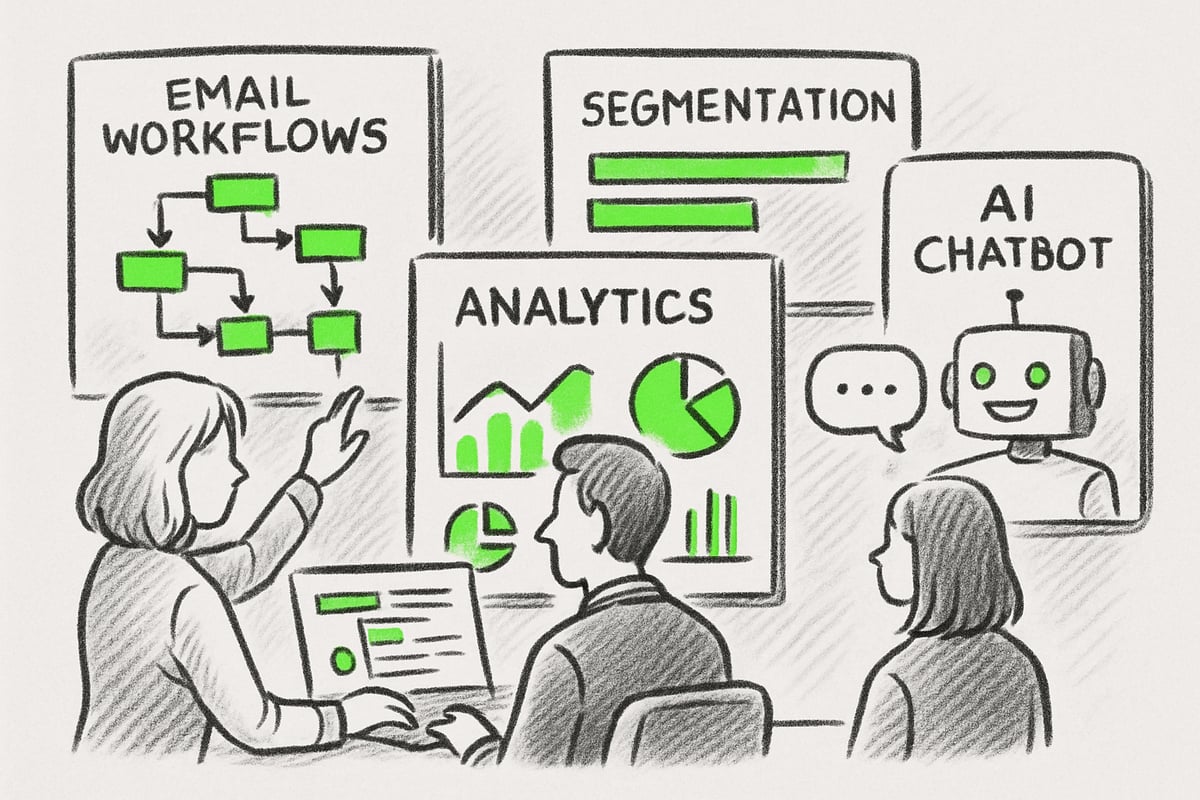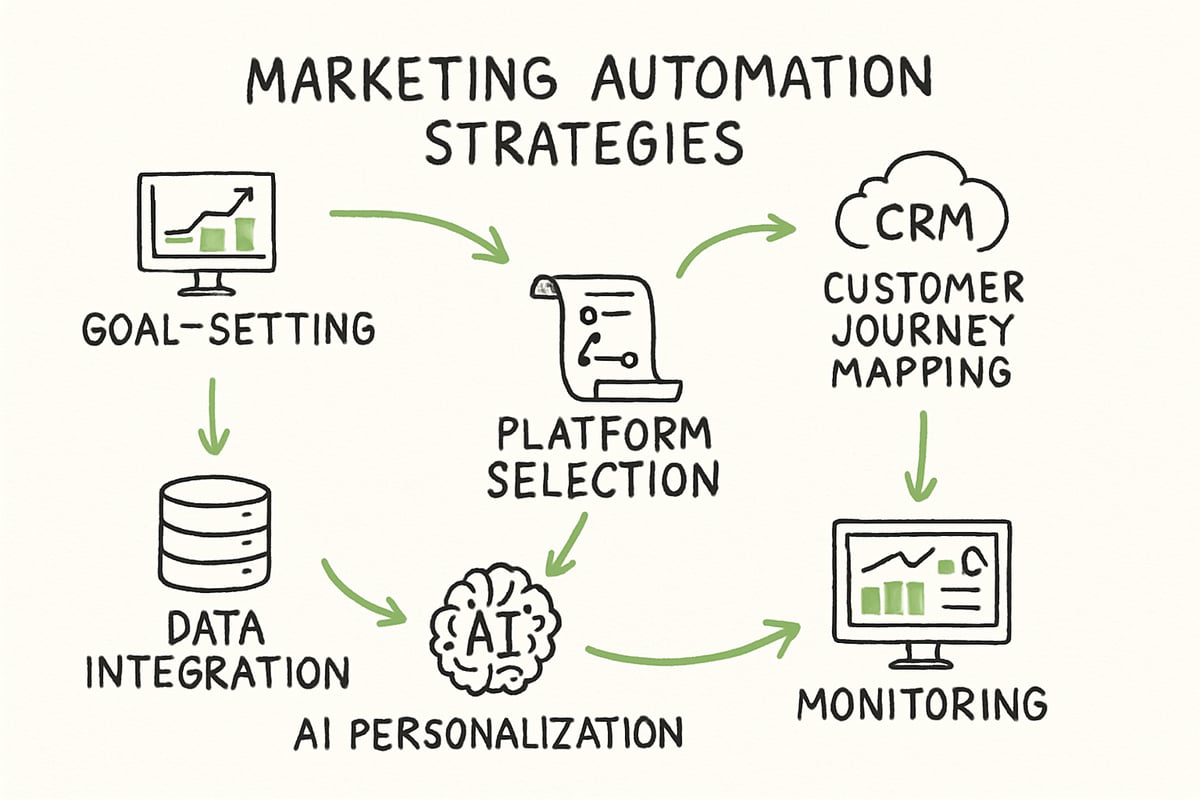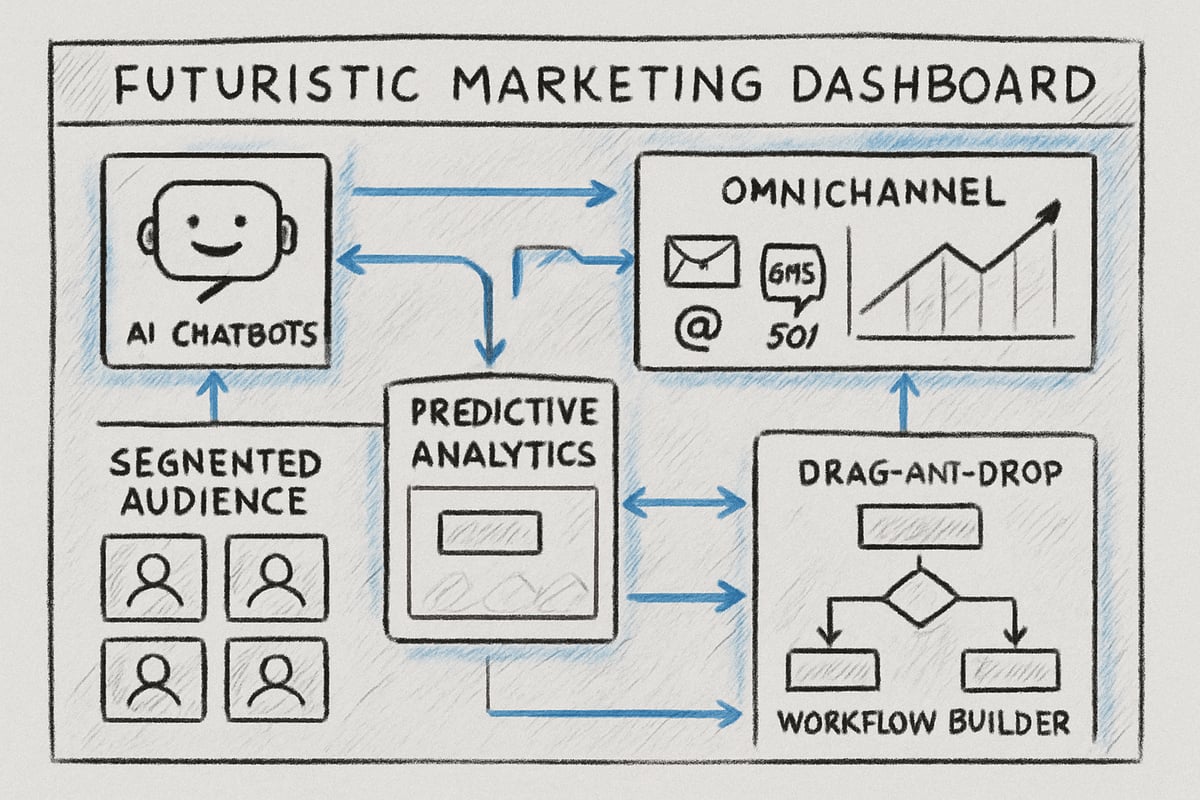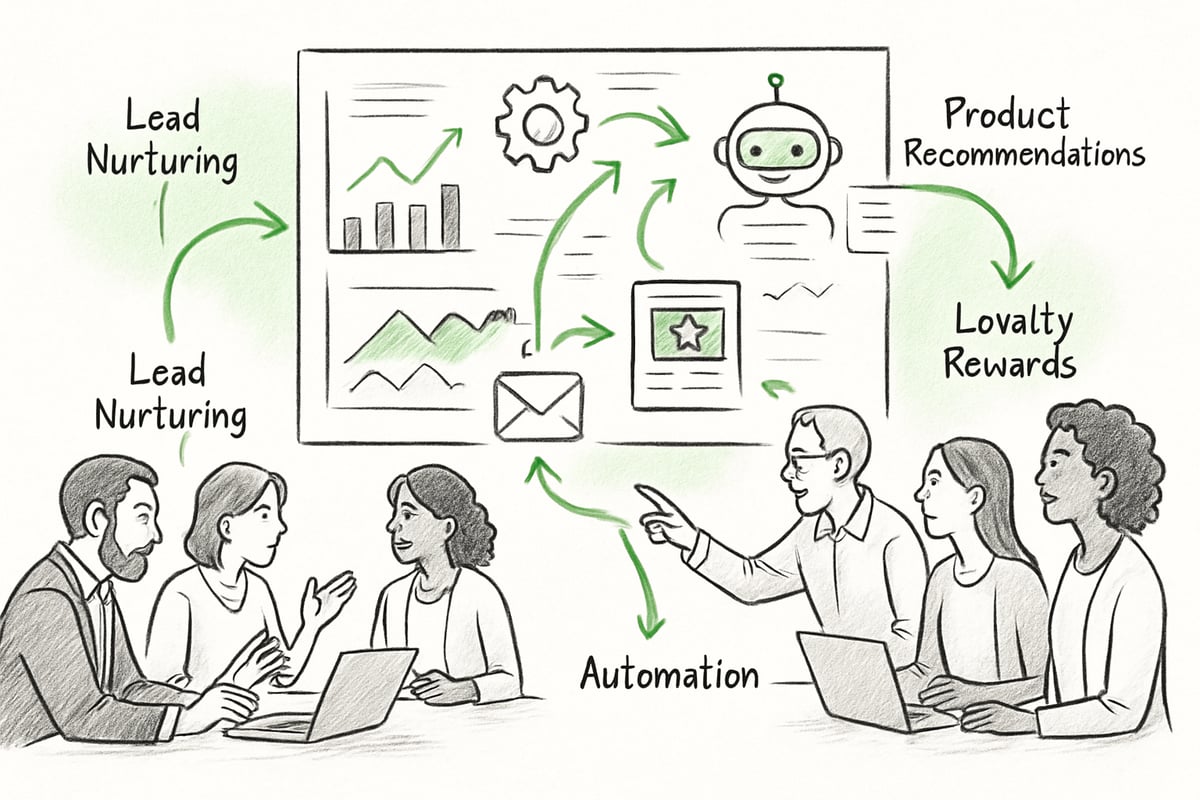The marketing world is changing rapidly, with automation for marketing and AI driving transformation at a pace never seen before. In 2025, staying ahead means understanding these technologies and using them to your advantage.
This guide will break down automation for marketing, making it clear and actionable for every business leader and marketer. You will discover proven strategies and the most important trends shaping the future of marketing.
Inside, you will find the fundamentals of marketing automation, step-by-step strategies, insights into emerging trends, real success stories, and expert tips to future-proof your efforts.
Are you ready to learn how to personalize campaigns, streamline operations, and boost ROI? Read on for a comprehensive guide that will help your business thrive in the digital age.
Understanding Marketing Automation: Core Concepts and Benefits
Marketing is rapidly transforming, and automation for marketing is at the core of this evolution. Understanding its fundamentals is essential for any business aiming to compete in 2025. Let us break down the core concepts, benefits, challenges, and evolution of automation for marketing.

What is Marketing Automation?
Automation for marketing refers to using technology to automate repetitive tasks, manage campaigns, and engage customers seamlessly. Its scope includes email workflows, lead nurturing, audience segmentation, analytics, and orchestrating campaigns across multiple channels.
Key components include:
- Automated email and SMS workflows
- Lead scoring and nurturing
- Audience segmentation
- Real-time analytics dashboards
- Omnichannel campaign orchestration
Leading platforms like HubSpot’s Marketing Hub and Salesforce Marketing Cloud are popular choices. According to HubSpot, 76% of companies already use automation for marketing basic tasks, highlighting its widespread adoption.
Benefits of Marketing Automation
Embracing automation for marketing offers significant advantages. It streamlines manual processes, allowing teams to focus on strategy rather than repetitive tasks. Enhanced personalization delivers tailored experiences to customers at scale, while automated lead management ensures prospects are scored, nurtured, and handed off to sales efficiently.
Consistency across channels is easier to maintain, and real-time analytics empower data-driven decisions. For example, HubSpot users have reported a 129% increase in leads within a single year. For a deeper dive into the advantages and obstacles, see Marketing Automation Benefits and Challenges.
Challenges and Considerations
While automation for marketing brings many benefits, it is not without challenges. Integrating new platforms with existing CRM, sales, or service systems can be complex. Data privacy and compliance with regulations such as GDPR and CCPA must be prioritized.
Initial setup and the learning curve can slow adoption, and there is a risk of over-automation, which may lead to impersonal customer experiences. Salesforce recommends focusing on unified data to ensure seamless automation for marketing.
The Evolution of Marketing Automation: 2020-2025
The landscape of automation for marketing has shifted dramatically from 2020 to 2025. Early solutions relied on simple rules, while today’s platforms leverage AI for smarter automation. Omnichannel and cross-platform capabilities are now standard, with real-time data and predictive analytics driving decisions.
Customer journey mapping has become central, allowing businesses to tailor outreach based on individual behaviors. Emerging trends include AI-driven personalization and the rise of conversational marketing, as seen in solutions like Salesforce Agentforce.
Key Strategies for Implementing Marketing Automation in 2025
Implementing automation for marketing in 2025 requires a strategic, step-by-step approach. To unlock real value, organizations must align technology with business objectives, customer journeys, and data management best practices. Let us walk through the six core strategies every marketer should adopt.

Step 1: Define Clear Marketing Goals and KPIs
The foundation of automation for marketing success is clear goal-setting. Start by identifying what you want to achieve, such as increasing lead generation, improving conversion rates, or boosting customer retention.
Break down each objective into measurable KPIs. For example, track the number of qualified leads per month or the percentage increase in email click-through rates.
Salesforce recommends goal-based automation planning to ensure every workflow aligns with business outcomes. This strategic alignment helps avoid wasted efforts and maximizes the impact of automation for marketing.
Step 2: Choose the Right Automation Platform
Selecting the appropriate platform is crucial for effective automation for marketing. Evaluate solutions based on CRM integration, AI capabilities, omnichannel support, and scalability.
Popular choices include HubSpot Marketing Hub for small businesses and Salesforce Marketing Cloud for enterprises. Consider your team's technical expertise and future growth plans to ensure the platform meets both current and evolving needs.
Look for user-friendly interfaces and robust support resources. The right platform will empower your team to manage automation for marketing with confidence and efficiency.
Step 3: Map and Automate the Customer Journey
To deliver seamless experiences, map out every stage of your customer journey. Identify key touchpoints from awareness to retention, and design automated workflows for each phase.
Use segmentation and triggers to tailor messaging based on user behavior and preferences. HubSpot’s journey-based automation tools make it easy to build workflows that adapt to each customer’s path.
When you connect automation for marketing to the entire journey, you create consistent, personalized interactions that drive engagement and loyalty.
Step 4: Integrate Data and Ensure Connectivity
Centralizing customer data is essential for successful automation for marketing. Integrate data from sales, service, and marketing channels using platforms like Salesforce Data Cloud or HubSpot Data Hub.
Ensure data accuracy, real-time syncing, and compliance with privacy regulations. Salesforce’s unified Customer 360 approach provides a single source of truth, making cross-functional automation seamless.
With integrated data, automation for marketing can deliver relevant, timely content while improving decision-making and reporting.
Step 5: Personalize Campaigns with AI and Machine Learning
Leverage AI and machine learning to elevate automation for marketing. Use AI-powered tools for dynamic content, predictive recommendations, and optimal send times.
Behavioral data enables hyper-targeted messaging, increasing relevance and conversion rates. For a deeper dive into integrating AI, explore Marketing and AI Integration Insights, which details practical ways to blend automation for marketing with advanced intelligence.
As AI evolves, personalized campaigns will become the norm, helping brands stand out in crowded digital spaces.
Step 6: Monitor, Analyze, and Optimize
Continuous monitoring and optimization are vital for automation for marketing. Set up real-time dashboards and automated reporting to track KPIs and spot trends.
Run A/B tests on workflows, messaging, and timing to find what works best. Adjust automation rules based on performance data, ensuring your strategies remain agile and effective.
HubSpot users report a 37 percent improvement in ticket closure rates when they regularly optimize their automation for marketing processes.
Emerging Trends in Marketing Automation for 2025
The landscape of automation for marketing is evolving rapidly, with new technologies and strategies redefining how brands connect with customers. In 2025, marketers must stay ahead by embracing trends that drive efficiency, personalization, and compliance. Understanding these emerging trends empowers businesses to leverage automation for marketing success and achieve measurable results.

AI-Driven Personalization and Conversational Marketing
AI-driven personalization is at the heart of automation for marketing in 2025. Marketers now deploy intelligent chatbots and virtual agents, such as Salesforce Agentforce and HubSpot Breeze, to deliver real-time, tailored interactions. These AI tools automate content creation, analyze customer intent, and respond instantly to inquiries. Businesses benefit from always-on engagement, ensuring no opportunity is missed. According to AI's Impact on Marketing Automation, AI integration is accelerating the shift toward hyper-personalized marketing at scale. As AI continues to evolve, expect deeper customer insights and more meaningful conversations.
Omnichannel Automation and Integration
Seamless integration across channels is a defining trend in automation for marketing. Modern platforms unify email, SMS, social media, web, and mobile campaigns, creating a consistent experience for every customer. Marketers use tools like HubSpot and Salesforce to orchestrate cross-channel journeys, ensuring messages reach audiences where and when it matters most. Unified data streams support cohesive storytelling and brand consistency. Companies leveraging omnichannel automation for marketing report higher retention rates and stronger engagement. The ability to manage communications from a single platform is now essential for effective campaign execution.
Predictive Analytics and Lead Scoring
Predictive analytics is transforming automation for marketing by enabling smarter, faster decisions. AI-powered models forecast customer behaviors, predict purchase intent, and automate lead scoring. Marketers can prioritize top prospects, automate qualification, and seamlessly hand off leads to sales teams. Salesforce’s predictive lead scoring in Sales Cloud exemplifies this trend, helping businesses target high-value opportunities. By integrating predictive analytics into automation for marketing, organizations optimize resource allocation and drive higher conversion rates. Real-time insights enable continuous refinement of campaign strategies and lead management processes.
Hyper-Personalized Content and Dynamic Segmentation
Delivering the right message to the right audience is easier with automation for marketing. Real-time segmentation tools analyze customer behavior, preferences, and lifecycle stages to group audiences dynamically. Platforms like HubSpot offer dynamic content blocks in emails and landing pages, adapting messaging to individual users. This hyper-personalization increases relevance and engagement across touchpoints. Marketers can automate campaigns that respond instantly to customer actions or changes in behavior. As a result, automation for marketing enables brands to build deeper relationships and foster greater loyalty.
Privacy-First Automation and Compliance
With evolving regulations, privacy-first automation for marketing is a top priority in 2025. Automated consent management tools ensure compliance with GDPR, CCPA, and other data privacy laws. Platforms such as Salesforce and HubSpot provide built-in features for managing preferences and securing data. Marketers must balance personalization with respect for privacy, automating processes to honor customer choices. Transparent data practices and real-time compliance checks reduce risk and build trust. Adopting privacy-first automation for marketing protects both customers and the brand reputation.
Low-Code/No-Code Automation Tools
Low-code and no-code platforms are democratizing automation for marketing. Marketers can now design, launch, and optimize workflows using intuitive drag-and-drop interfaces, without relying on developers. Tools like HubSpot’s visual editor and Salesforce Flow Automation empower teams to iterate quickly and experiment with new strategies. This accessibility accelerates campaign deployment and allows for rapid adaptation to market changes. Automation for marketing becomes scalable, flexible, and accessible to businesses of all sizes. Investing in low-code solutions helps organizations future-proof their marketing operations.
Real-World Applications and Success Stories
Marketing teams across industries are achieving measurable results by leveraging automation for marketing. Real-world applications showcase how businesses of all sizes use automation for marketing to streamline processes, personalize customer journeys, and drive sustained growth.

B2B Lead Generation and Nurturing
Automation for marketing has transformed B2B lead generation. Companies deploy automated email sequences, lead scoring, and smart segmentation to qualify prospects efficiently. For example, HubSpot users have reported a 129% increase in leads within a single year.
- Automated lead nurturing keeps prospects engaged.
- Scoring systems prioritize high-value opportunities.
- Seamless handoff from marketing to sales ensures no lead is lost.
Salesforce CRM integrates these features, allowing marketing and sales teams to collaborate with unified data. According to Marketing Automation Adoption Rates, the majority of B2B organizations now rely on automation for marketing to stay competitive.
B2C Personalization at Scale
In the B2C sector, automation for marketing enables brands to deliver personalized experiences at scale. Retailers use dynamic product recommendations and triggered campaigns to engage shoppers across channels.
- Automated workflows respond instantly to customer actions.
- AI-driven engines suggest relevant products based on behavior.
- Omnichannel delivery ensures consistent messaging.
Salesforce Marketing Cloud empowers brands to build these journeys, increasing conversion rates and customer satisfaction. By using automation for marketing, B2C teams can tailor every interaction, turning browsers into loyal buyers.
Customer Retention and Loyalty Programs
Retention is a critical application of automation for marketing. Automated feedback requests, loyalty rewards, and re-engagement campaigns help brands nurture long-term relationships.
- Timely surveys gather actionable insights from customers.
- Automated point accrual and rewards keep loyalty programs active.
- Re-engagement messages win back inactive users.
Salesforce Loyalty Management is a prime example, offering seamless orchestration of retention strategies. Automation for marketing ensures consistent follow-up, driving higher lifetime value and reducing churn.
Small Business Automation Wins
Small businesses benefit from automation for marketing by adopting starter bundles like HubSpot’s Marketing Hub or Salesforce Essentials. These platforms offer affordable, scalable solutions for growing teams.
- Pre-built templates simplify campaign launches.
- Visual workflow editors reduce setup time.
- Automated reminders and follow-ups boost sales productivity.
Many small businesses report increased sales and efficiency after implementing automation for marketing. By starting with core workflows and expanding over time, even modest teams can achieve enterprise-level results.
Best Practices and Pitfalls to Avoid in Marketing Automation
Marketing success in 2025 depends on using automation for marketing wisely, not just widely. The right approach can elevate customer experiences, drive efficiency, and increase ROI. However, pitfalls exist for those who overlook strategy, data, or the human touch. Explore these best practices and common mistakes to ensure your automation for marketing delivers lasting impact.
Aligning Automation with Customer Experience
The foundation of automation for marketing is enhancing, not replacing, customer relationships. Every workflow should map to a specific stage in the customer journey. When automation is misaligned, it can create robotic messaging and frustrate users.
- Map automated touchpoints to awareness, consideration, and decision stages.
- Design triggers that respond to customer actions, not just time-based schedules.
- Personalize messages with dynamic fields and contextual content.
Remember, the goal is to support genuine engagement. Over-automation risks losing brand personality and trust. For deeper insight on where AI fits into customer experience, see AI for Marketing Strategies.
Data Quality, Integration, and Security
Automation for marketing is only as strong as the data fueling it. Poor data quality leads to mistargeted campaigns, compliance risks, and missed opportunities.
- Regularly clean and validate data sources across CRM, sales, and service.
- Integrate platforms for a unified 360-degree view of each customer.
- Prioritize security, encrypt sensitive data, and comply with evolving privacy laws.
Consider using platforms that offer robust data management features and compliance tools. Secure integration protects both your brand and your customers’ trust.
Continuous Testing and Optimization
No automation for marketing strategy is set-and-forget. Continuous improvement ensures ongoing relevance and success.
- Run A/B tests on subject lines, content, and workflows.
- Analyze performance metrics in real time using dashboards.
- Identify bottlenecks and iterate based on actionable insights.
Use analytics not just for reporting, but for learning what truly resonates with your audience. Small tweaks, informed by data, can lead to significant gains.
Avoiding Over-Automation and Maintaining Human Touch
While automation for marketing streamlines operations, it should never replace authentic interactions. Customers still crave human support and understanding.
- Balance automated responses with live support options.
- Monitor feedback to spot when automation falls short.
- Blend AI-driven tools with personal outreach for complex issues.
Brands like Salesforce and HubSpot stress the importance of combining automation with empathy. Thoughtful use of technology will keep your marketing strategy both efficient and human-centered.
Future-Proofing Your Marketing Automation Strategy
Future-proofing your automation for marketing efforts is essential for long-term growth and adaptability. As digital transformation accelerates, staying ahead means continually evolving your strategies and tools. This section explores practical steps to ensure your marketing automation remains effective, scalable, and ready for what comes next.
Embracing Innovation and Staying Agile
Keeping your automation for marketing strategy at the cutting edge requires a mindset of continuous learning and adaptability. The pace of change in technology means new features and best practices emerge regularly. Encourage your team to stay informed and invest in ongoing training through resources like HubSpot Academy or Salesforce Trailhead.
Exploring innovative tools is also key. Reviewing Essential AI Tools for Marketing can help identify solutions that streamline campaigns, improve personalization, and boost efficiency. By fostering a culture of curiosity and agility, you ensure your marketing automation evolves with industry advancements.
Scaling Automation as Your Business Grows
As your business expands, your automation for marketing must scale to meet increasing demands. Start with simple workflows, then gradually introduce more complex automations as your needs evolve. Choose platforms that support modular growth, such as HubSpot’s flexible bundles or Salesforce’s enterprise-level customization.
Assess the scalability of your chosen tools and ensure they integrate seamlessly with your existing systems. Industry data shows the marketing automation market is projected to grow, underlining the importance of future-ready solutions. A scalable approach minimizes disruption and maximizes long-term ROI.
Measuring ROI and Business Impact
To justify investments in automation for marketing, robust measurement is crucial. Track key performance indicators such as lead volume, conversion rates, and customer lifetime value. Use real-time dashboards and automated reports for transparent results and actionable insights.
Regularly analyze which workflows generate the most value and where improvements can be made. Referencing industry benchmarks, such as those found in Marketing Automation Industry Revenue Growth, provides context for evaluating your performance. Data-driven decisions ensure your marketing automation delivers measurable business impact.
Preparing for the Next Wave: AI, Voice, and Beyond
Looking ahead, automation for marketing will increasingly leverage advanced AI, voice assistants, and IoT integrations. Begin experimenting with these technologies now to prepare for evolving customer expectations and new communication channels.
Plan for flexibility by choosing platforms that adapt to future trends. Stay engaged with industry thought leadership and explore resources like the Green Alien Lab Blog for insights on emerging tools and strategies. By anticipating change, your marketing automation strategy remains resilient and future-ready.
